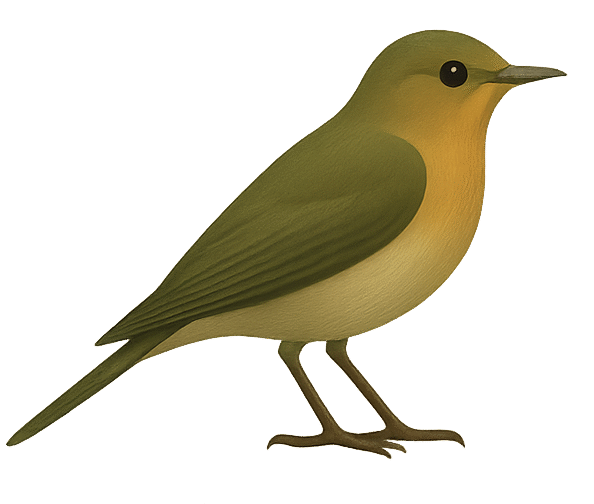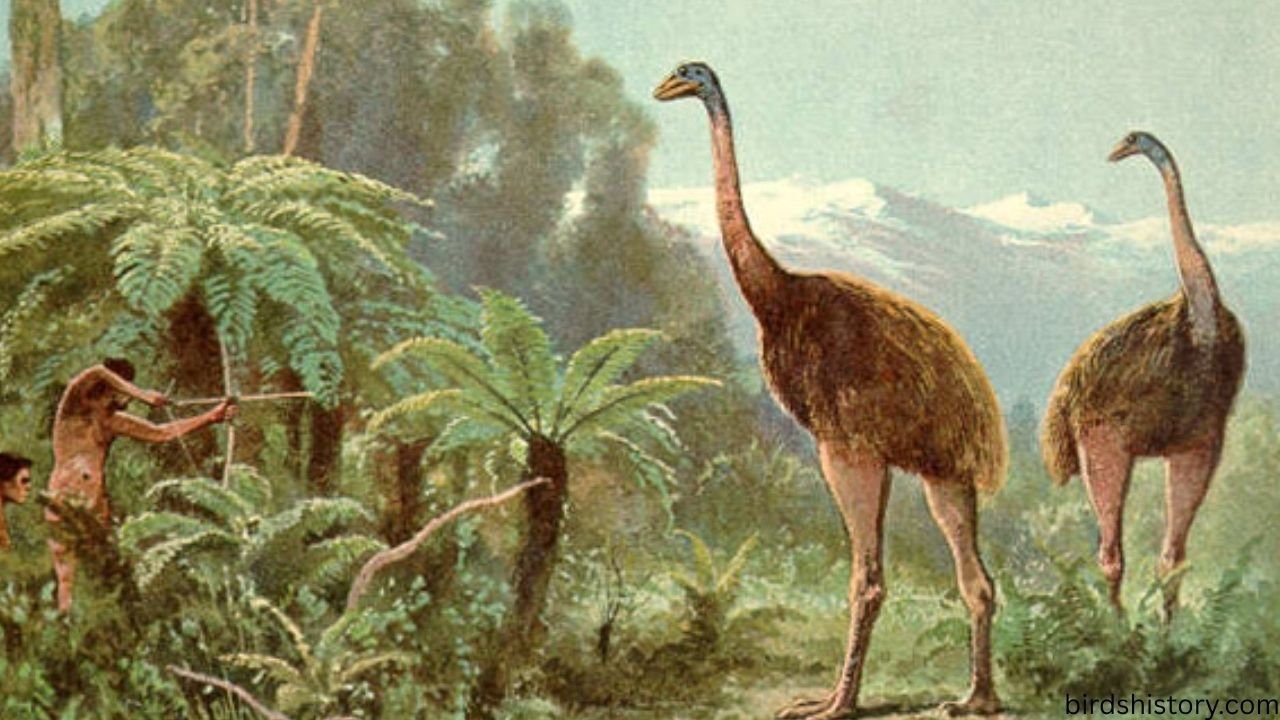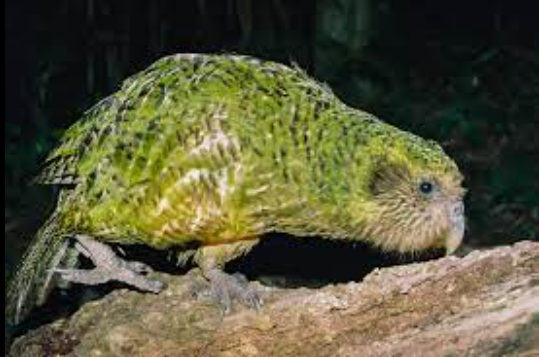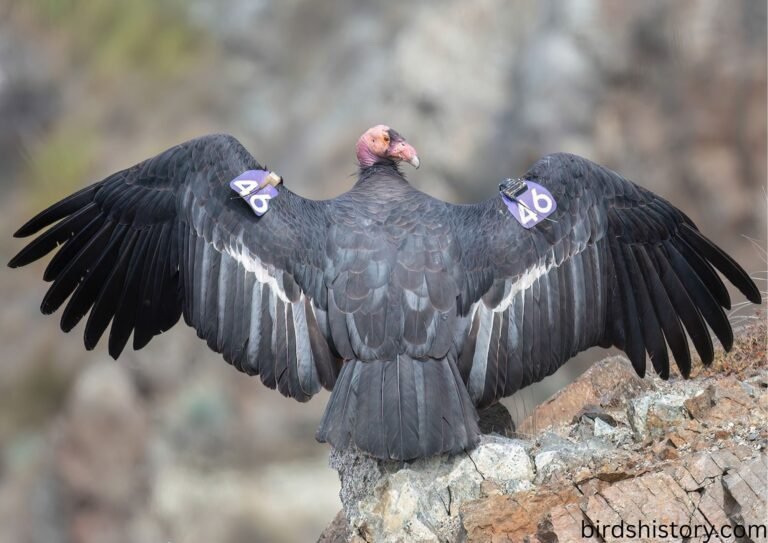The Giant Moa: Nature’s Lost Giant of New Zealand
The Giant Moa is one of the most fascinating and mysterious birds to have ever lived. Native to New Zealand, this flightless giant towered over most other animals in its environment and left behind a legacy that continues to capture scientific and public interest. What makes the Giant Moa especially intriguing is its enormous size—some species stood nearly 12 feet tall when stretching their necks upward. This made them not only the tallest birds to have ever lived but also some of the heaviest, with certain individuals weighing over 500 pounds.
What’s even more surprising is that the Giant Moa had no wings at all—not even small ones like those found in ostriches or emus. Their complete lack of wings makes them unique among birds. Sadly, they became extinct just a few hundred years ago due to human hunting and habitat destruction. Still, their story lives on through fossils, oral traditions of the Māori people, and ongoing scientific studies.
In this article, we’ll explore everything about the Giant Moa: from its scientific classification to its lifestyle, diet, threats, and eventual extinction. Along the way, we’ll uncover fascinating facts that show why this bird continues to hold such an important place in natural history.
Giant Moa Taxonomy / Classification
To understand the Giant Moa better, let’s look at where it fits in the bird family tree.
- Common Name: Giant Moa
- Scientific Name: Dinornis
- Family: Dinornithidae
- Order: Dinornithiformes
- Class: Aves
Also read: /the-elephant-bird/
The name Dinornis translates to “terrible bird,” a fitting title for such a massive creature. The Giant Moa was part of a diverse group of flightless birds that included smaller moa species as well. In total, there were about nine known moa species, but the Dinornis genus represented the largest.
Interestingly, DNA analysis has revealed that the Giant Moa’s closest living relatives are not ostriches or emus, as many might assume, but rather the small South American tinamous. This surprising link shows how bird evolution can take very different paths depending on the environment.
Giant Moa Physical Description
The giant moa was an exceptionally extreme bird. Here’s what made its appearance remarkable:
- Size: Adult females could reach heights of up to 3.6 meters (around 12 feet) when fully stretching their necks. Males were significantly smaller, averaging about half the weight and two-thirds the height of females.
- Weight: Females weighed around 440–550 pounds (200–250 kg), while males were much lighter.
- Sexual Dimorphism: The size difference between males and females was one of the most extreme among birds, with females being nearly twice as large.
- Unlike the majority of other birds that cannot fly, the Giant Moa possessed absolutely no wings. Not even vestigial structures remained.
- They had powerful beaks and long, flexible necks, which were well-suited for pulling leaves, twigs, and fruits from plants.
- Feathers: Fossilized remains suggest they had a shaggy coat of feathers, providing insulation in cooler environments. Their plumage was likely brownish or mottled, helping them blend into forested habitats.
- Legs and Feet: They had powerful legs designed for walking and foraging, not for speed. Unlike ostriches, they were not fast runners.
This unique combination of traits made the Giant Moa one of the most unusual birds ever discovered.
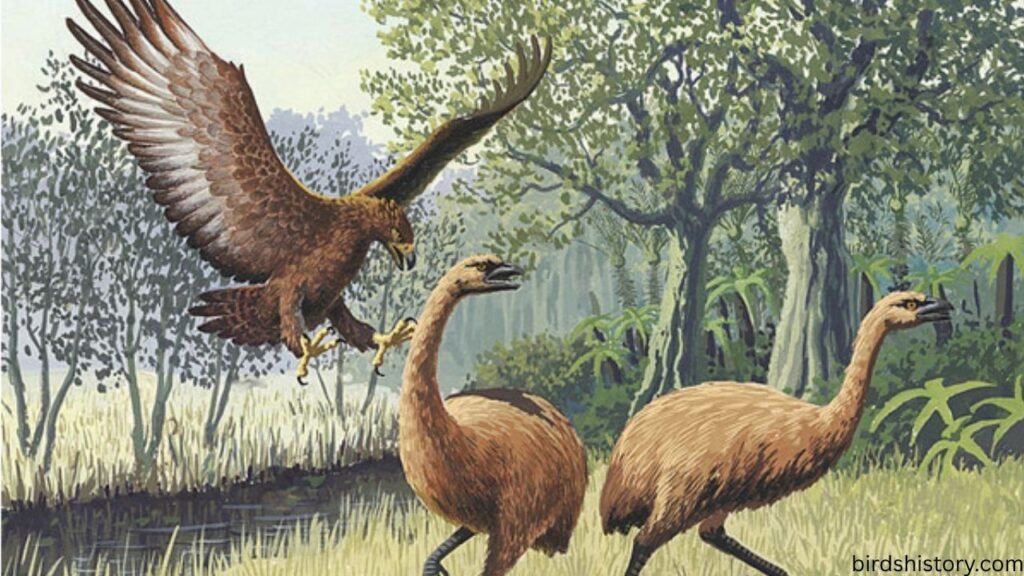
Habitat and Range of Giant Moa
The Giant Moa was endemic to New Zealand, meaning it was found nowhere else in the world. Its distribution was wide, covering both the North and South Islands.
- The Giant Moas lived in a variety of environments, including forests, shrublands, and grasslands. Thanks to their lengthy necks, they could eat leaves that were out of reach for smaller creatures.
- Range:
- North Island: Populations of smaller Dinornis novaezealandiae
- South Island: Larger Dinornis robustus, the heaviest of all moa species
- Climate Adaptability: They were well-suited to different climates, from coastal regions to alpine zones.
Because New Zealand had no native land mammals (other than bats), the Giant Moa occupied a role similar to large herbivores elsewhere, acting as the main browsers of vegetation.
Giant Moa Diet and Feeding Habits
The Giant Moa was a strict herbivore. Its diet mainly consisted of:
- Leaves
- Twigs
- Fruits
- Seeds
- Grasses
Its strong beak and flexible neck allowed it to feed at different heights, giving it access to food sources other animals couldn’t reach. Scientists have studied fossilized plant material found in moa coprolites (fossilized droppings), confirming their diverse plant-based diet.
Unlike ostriches, which graze on low plants, Giant Moas acted more like browsing giraffes, plucking vegetation from shrubs and trees. This made them vital for seed dispersal and vegetation balance in prehistoric New Zealand.
Behavior and Lifestyle of Giant Moa
The lifestyle of the Giant Moa was shaped by its unique environment.
- Social or Solitary: Evidence suggests that Giant Moas were mostly solitary or lived in small groups rather than large flocks.
- Flight Style: Completely flightless. With no wings, they relied entirely on their legs.
- Movement: They were not particularly fast but were capable of covering large distances while foraging.
- Nesting Habits: Fossil records and Māori oral traditions suggest they built ground nests in sheltered areas.
- Vocalizations: Some researchers believe they may have produced deep, resonant calls, similar to emus, but this is speculative.
- Mating Rituals: The enormous size difference between males and females likely influenced their mating behaviors, with males competing for access to larger females.
Overall, their lifestyle was slow-paced, centered on browsing, and shaped by the absence of large mammalian predators.
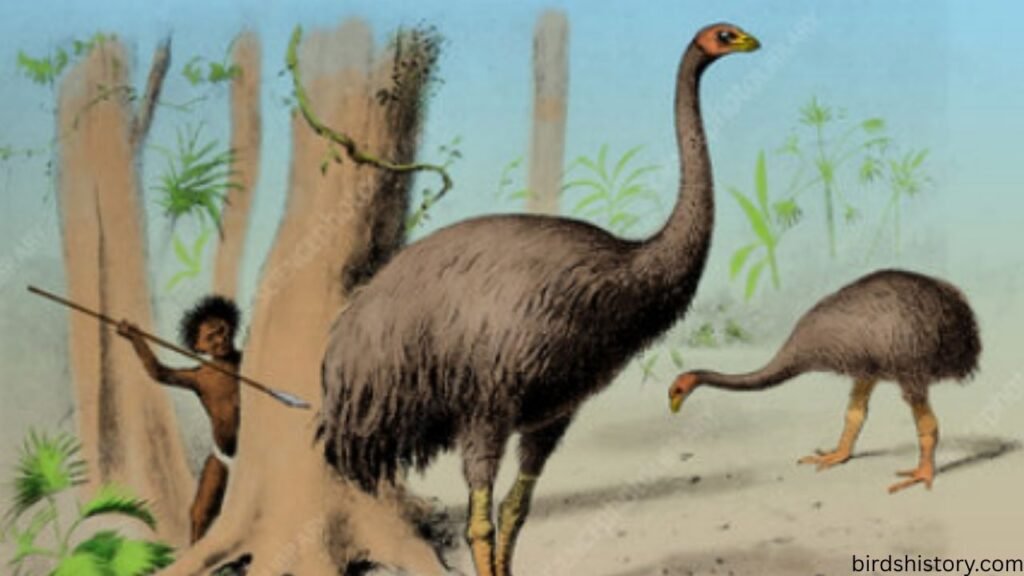
Giant Moa Reproduction and Lifespan
Reproduction in the Giant Moa remains partly mysterious, but studies give us some insights:
- Breeding Season: Likely seasonal, possibly during warmer months when food was abundant.
- Nesting: Eggs were laid in ground nests, often hidden in vegetation.The Giant Moas laid their eggs in nests on the ground, which were typically concealed by surrounding plants.
- Eggs: Moa eggs were enormous, some reaching up to 24 cm (9.5 inches) in length. The shells were surprisingly thin, making them fragile.
- Parental Care: Research suggests males may have been the primary caregivers, incubating the eggs and caring for chicks.
- Lifespan: Estimates suggest they could live up to 40–50 years in the wild.
This reproductive strategy, while effective in a predator-free environment, made them highly vulnerable once humans arrived in New Zealand.
Predators and Threats
Before human arrival, the Giant Moa had only one major natural predator:
- Haast’s Eagle (Hieraaetus moorei): The largest eagle to have ever lived, with a wingspan up to 3 meters (10 feet). It preyed primarily on moa, swooping down to attack adults and chicks alike.
However, the biggest threats to the Giant Moa came from humans:
- Hunting: When the Māori people arrived in New Zealand around the 13th century, they hunted moas extensively for meat, eggs, and feathers.
- Habitat Destruction: Forest burning and land clearance reduced the moas’ natural habitat.
- Egg Collection: Because moa eggs were large and nutritious, they were heavily collected, leading to low reproduction rates.
Within just 200 years of human settlement, the Giant Moa population collapsed.
Giant Moa Conservation Status
Today, the Giant Moa is classified as extinct.
- Extinction Date: Believed to have disappeared by the late 15th century.
- IUCN Status: Extinct.
- Conservation Efforts: While the Giant Moa cannot be revived, its story plays an important role in New Zealand conservation, highlighting the fragility of island ecosystems.
Modern conservation projects in New Zealand, such as predator control and forest restoration, are indirectly inspired by the lessons learned from the moa’s extinction.
Interesting Facts about the Giant Moa
- The giant moa holds the record for the tallest bird ever to exist.
- It had no wings at all, unlike ostriches, emus, or kiwis.
- Māori legends describe the moa as a key food source and a giant bird of the forest.
- Not long after the moa disappeared, its predator, the Haast’s Eagle, also went extinct.
- Moa eggs were so large that one could feed a family.
- Scientists are studying moa DNA, sparking debates about whether de-extinction could one day bring them back.
Conclusion
The Giant Moa was more than just a bird—it was an icon of New Zealand’s natural history. Towering above other animals, it played a vital role in shaping the environment and culture of the islands. Its extinction serves as a powerful reminder of how human activity can rapidly alter ecosystems.
By learning about the Giant Moa, we gain not only a deeper appreciation for this unique species but also valuable insights into the importance of protecting today’s endangered birds. After all, the story of the Giant Moa shows us just how quickly giants can fall when nature’s balance is disturbed.
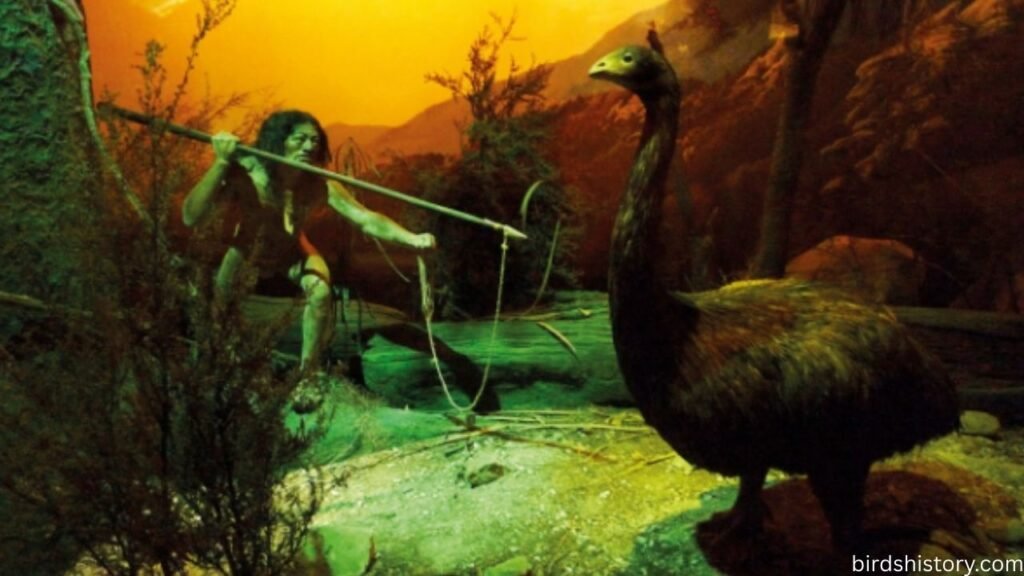
FAQs
1. What was the Giant Moa’s scientific name?
Dinornis, meaning “terrible bird.”
2. How tall was the Giant Moa?
Up to 12 feet when stretching its neck.
3. Did the Giant Moa have wings?
No, it had no wings at all.
4. What did the Giant Moa eat?
Leaves, twigs, fruits, and seeds.
5. Where did the Giant Moa live?
Exclusively in New Zealand.
6. What killed the Giant Moa?
Overhunting and habitat destruction by humans.
7. Did the Giant Moa have predators?
Yes, mainly Haast’s Eagle before humans arrived.
8. How big were moa eggs?
Up to 24 cm long, among the largest bird eggs ever.
9. When did the Giant Moa go extinct?
By the late 15th century.
10. Can the Giant Moa be brought back?
Not yet, though some scientists study the possibility of de-extinction using DNA.
